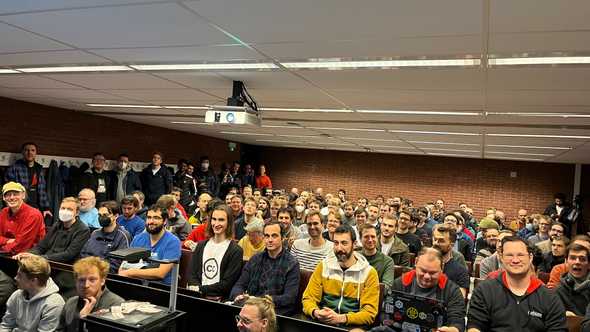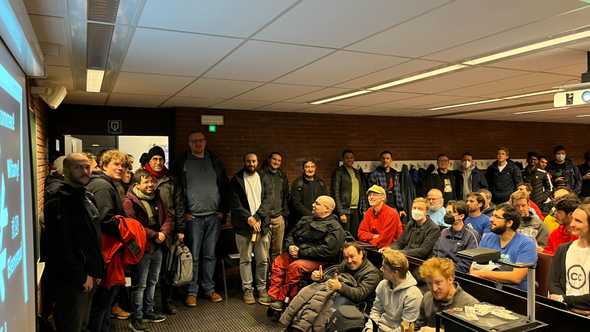February started with a busy week for several of us Tweagers. We went as a group — or, dare I say, a delegation — to FOSDEM23 and CfgMgmtCamp23 (Config Management Camp if, like me, you can’t read through so many consonants). Tweagers Bryan Honof and Théophane Hufschmitt, together with Ryan Lahfa, Julien Malka and Matthew Croughan from the Nix community, got us the first Nix DevRoom at FOSDEM. And not the last, as you can see from the picture below; the room just couldn’t handle the Nix fame!
Our involvement didn’t end there. At FOSDEM:
- Théophane presented the new Nix (core) team.
- Guillaume Desforges lightened the mood with his enthusiastic talk on making anyone use Nix.
- I went on to introduce Nixel, a framework to write Nix expressions in Nickel.
Followed right away by CfgMgmtCamp:
- Bryan first did a lightning talk to tease Nix, then took curious people on a deeper dive during a 50-minute gentle introduction to Nix.
- Viktor Kleen presented his work on Terraform-Nickel, a library to use Nickel in place of HCL for Terraform.
- I talked about how to write modular and customizable configuration using Nickel’s merging system.
What follows are my takeaways on the trends and the trajectory of infrastructure and configuration management. Please don’t take my word as a confident prediction, as predictions don’t age well. This post is merely a patchwork of my biased, fresh impressions — as a programming language nerd rabbit-holed into devops and infrastructure by Nix — on my way back home.
Self-service infrastructure
Several key speakers at CfgMgmtCamp emphasized how much infrastructure is critical for many business services and how, more often than not, it is a bottleneck in practice.
Developers must be able to spin up new services rapidly, not in hours or days. They can’t wait one week for someone from the infra team to finally find time, between daily maintenance tasks, to hit the green button (or do something more complex), potentially followed by a long painful back-and-forth. Non-technical roles, such as marketing and sales, might also need to get a small website or a service up, but are even less empowered.
This doesn’t mean one should give everyone full access to the infrastructure. I’ve rather heard a call for simpler, safer, and better automated processes. For example, having a simple web interface for spinning up instances, with a clear policy on cleaning inactive resources. The interface shouldn’t require much infrastructure knowledge nor expose low-level options: this isn’t simply about granting people access to an AWS console. If users are developers, this can be achieved using infrastructure as code as well, with adapted restrictions.
Continuous integration, continuous delivery, one-off experiments — all those components should be automated, fully integrated in the software development workflow, and just a few clicks (or keystrokes, for you Vimmers) away.
YAML is dead
I’m sorry, that was just clickbait. YAML has been pronounced dead for the last 10 years or so, and unfortunately, here it stands.
But something is in the air. There is an undeniable movement toward a unified and structured approach to writing and managing configuration.
Scattering configuration data, schemas and knowledge across many different tools, written in many different languages (HCL, YAML, JSON, TOML, Puppet, Ansible, Helm, etc.) isn’t sustainable. And I feel like we can state a variant of Greenspuns’ tenth rule of programming for configuration:
Every sufficiently complicated infrastructure tool’s native configuration language is an ad-hoc, informally-specified, bug-ridden, arbitrarily-limited reinvention of half of CommonLisp.
This is exactly why we created Nickel. Projects that were the new kids on the block a few years ago — I’m thinking about Pulumi or CUE, for example — are gaining strength and run today in production. Those are not curiosities any more. The actors behind those tools seem to share the same dissatisfaction with the state of configuration management and infrastructure engineering. While our experience and vision led us to come up with our own answer (Nickel), we are all trying to unify configuration management by using a common language or platform.
Declarative, but what about interactive?
Adam Jacob’s opening talk on Breaking The Rules, as well as Ringo De Smet’s talk on Pulumi’s imperative on top of declarative approach made me think about the user experience aspect of declarative configuration. I’m still convinced that the declarative approach is ultimately the right one, or the only sustainable one to this day.
However, there is something to be said about offering different interfaces
to this declarative layer: Pulumi is one example, providing an imperative API to
manipulate it. npm add is another simple example of an imperative interface to
a declarative configuration (packages.json).
Adam introduced the notion of “infrastructure as a model”, instead of code, to which code would only be one possible interface. Which reminded me of similar internal discussion at Tweag about projectional editors, which is in fact the very same idea but applied to programming in general. Textual code is just one view, but other views — such as a graphical interface — of the abstract representation of a program are also possible, and more desirable for some tasks (refactoring, renaming, diffing, visualizing, …). Typically, a diagrammatic view is often better than text at clarifying the relations and dependencies between the entities being managed (e.g. Terraform resources). To each task, its projection?
Nix is getting stronger every year
Ron Efroni, from Flox, often makes the half-joke that the number of GitHub stars on the Nix repos are following Moore’s law: they double every two years. So far, he’s mostly right.
I was impressed by the number of people flooding the Nix DevRoom at FOSDEM (the pictures at the beginning of this post), queuing in the corridor to wait for a free spot.
At CfgMgmtCamp, Bryan’s lightning talk on Nix took place on the main track during the very first morning. The (huge) auditorium was full, fitting several hundred people. When he asked who knew about Nix, I expected a solid 50 people to raise their hand. More than half, probably around two third of the audience, raised their hand!
Nix is vibrant
A lot of cool things are happening in the Nix world. The ecosystem is evolving at a fast pace. The NixOS Foundation, itself rather new, is structuring to handle the change of scale, for example with a dedicated Nix maintenance team. Flox just released the first version of their product. Domen Kozar introduced devenv.sh, which has gained traction rapidly. We presented Nixel, the starting point of a whole new user experience for writing Nix.
Nickel
We got a lot of encouraging words after our various talks on Nickel. The project has been making steady progress in the long run, but the hard and technical work on the core language, the type system and the semantics of merging is naturally less palpable.
However, we have reached the point from where we can start (and have started, in fact) to harvest impactful outcomes, which is exciting. A handful of months’ work on the LSP by our own Gaga Ebresafe and we are already able to provide completions based on definitions, types and contracts, in-code documentation, code navigation and typechecking live in the editor, which is quite ahead of the current Nix experience. Although it’s only the beginning, we can already write basic derivations and modular and overridable development shells using Nixel. Daniele Palombi is doing an internship to bring incremental evaluation and self-adjusting computations to the interpreter, for fast re-evaluation of a configuration upon a small change.
Concluding words
It’s hard to say where the current momentum will bring us. Getting people excited and aware of a cool technology is not the same as making it established and used in production. There are many non-technical determining factors, even irrational ones. Nonetheless, it’s clear that infrastructure engineering is distinguished by the ebullience of its youth. It’s an exciting time to be around!
Behind the scenes
Yann is the head of the Programming Languages & Compiler group at Tweag. He's also leading the development of the Nickel programming language, a next-generation typed configuration language designed to manage the growing complexity of Infrastructure-as-Code and a candidate successor for the Nix language. You might also find him doing Nix or any other trickery to fight against non-reproducible and slow builds or CI.
If you enjoyed this article, you might be interested in joining the Tweag team.

